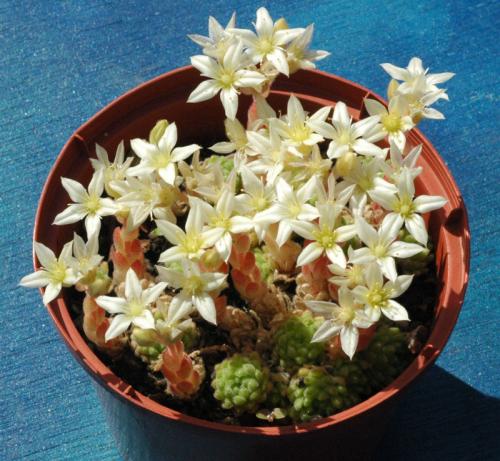AIZOON (Fenzl) 't Hart, 1995
Synonyms :
Umbilicus aizoon Fenzl (1842) / Cotyledon aizoon (Fenzl) Schönland (1890) / Sedum chrysanthum var. aizoon (Fenzl) Hamet (1929) / Rosularia aizoon (Fenzl) A.Berger (1930) / Sedum chrysanthum ssp. aizoon (Fenzl) R.T.Clausen (1975)
Umbilicus pallidus Schott & Kotschy (1857) / Rosularia pallida (Schott & Kotschy) Stapf (1923)
Rosularia tauricola Kit Tan (1989)
Distribution : Turkey, Armenia.
Description (according to Henk 't Hart in IHSP, 2003) :
Caudex absent, roots as thickened taproot to 4 mm in diameter.
Rosettes sessile, ± semiglobular, 1.5 - 3 cm in diameter, commonly in small groups and densely packed, offsets shortly stalked or subsessile.
Leaves oblong to narrowly elliptic, sometimes spatulate, fresh to blue-green (ochre and papery when dry), densely glandular-hairy, apex rounded.
Inflorescences ± reduced and normally lateral thyrses, lax or dense, 3- to 12-flowered.
Flowers broadly funnel-shaped or opening star-like, outer parts glandular-hairy, petals 7 - 8 mm or longer, united for 1/3, dark sulfur to golden-yellow, venation concolorous or rarely purplish.
Cytology : 2n = 14, 26, 28, 70
Material in cultivation under this name frequently turns out to be P. chrysanthum, which is primarily distinguished by the inflorescence always being terminal, and by its more tubular-campanulate flowers. Diploid plants are common throughout the area of the species. The tetraploid and decaploid cytotypes were all reported for plants from South-Eastern Turkey.
